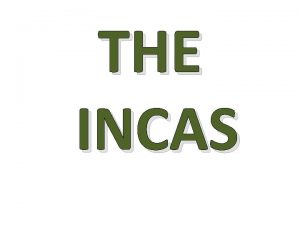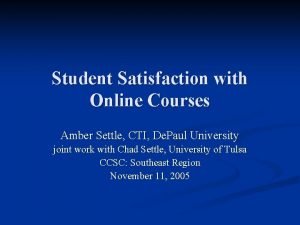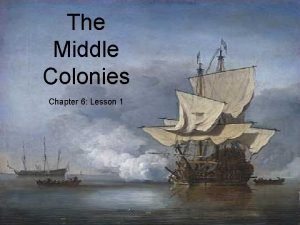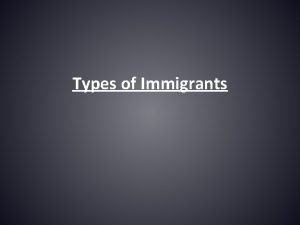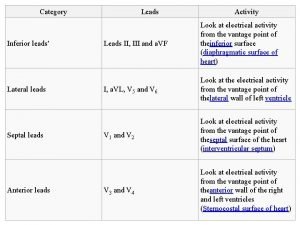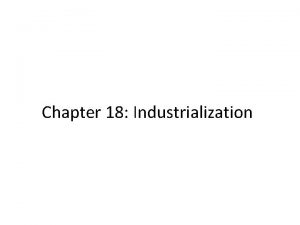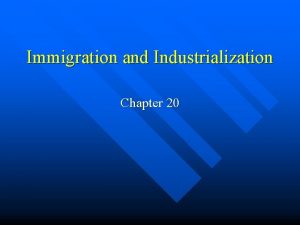Immigrants Settle in Cities v Industrialization leads to



















- Slides: 19

Immigrants Settle in Cities v Industrialization leads to urbanization, urbanization or growth of cities v Most immigrants settle in cities; get cheap housing, factory jobs v *Americanization—assimilating people into American culture Americanization v Schools, voluntary groups teach citizenship skills § English, American history, cooking, etiquette v Ethnic communities provide social support

Housing v. Working-class families live in houses on outskirts or boardinghouses v. Later, row houses built for single families v. Immigrants take over row houses, 2– 3 families per house *Tenements—multifamily urban dwellings, are *Tenements overcrowded, unsanitary Transportation v. Mass transit —move large numbers of people along fixed routes v. By 20 th century, transit systems link city to suburbs

Water v 1860 s cities have inadequate or no piped water, indoor plumbing rare v Filtration introduced 1870 s, chlorination in 1908 Sanitation v Streets: manure, open gutters, factory smoke, poor trash collection v Contractors hired to sweep streets, collect garbage, clean outhouses-------often do not do job properly v By 1900, cities develop sewer lines, create sanitation departments

Crime v As population grows, thieves flourish v Early police forces too small to be effective Fire v. Fire hazards: limited water, wood houses, candles, kerosene heaters v Most firefighters volunteers, not always available v 1900, most cities have full-time, professional fire departments v Fire sprinklers, non-flammable building materials make cities safer

The Emergence of Political Machines *Political Machine. Organized group that controls a city’s political party • Give services to voters, businesses for political, financial support • After Civil War, machines gain control of major cities • Machine organization: precinct captains, ward bosses, city boss

The Role of the Political Boss • May serve as mayor; he: • controls city jobs, business licenses • influences courts, municipal agencies • arranges building projects, community services • Bosses paid by businesses, get voters’ loyalty, extend influence Immigrants and the Machine • Many captains, bosses 1 st or 2 nd generation Americans • Machines help immigrants with naturalization, jobs, housing Election Fraud and Graft • Machines use electoral fraud to win elections *Graft—illegal use of political influence for personal gain • Machines take kickbacks, bribes to allow legal, illegal activities

Corrupt political leader put New York City in debt üPolitical boss • 1851 elected to city council • 1852 served in Congress • Kept * Tammany Hall-the Democratic Party in power in NYC • Formed the Tweed Ring • Bought votes, encouraged corruption, controlled NYC politics

v. Received large fees for interests (*kickbacks) from the Erie Railroad v. Tweed Ring milked the city with false leases, padded bills, false vouchers, unnecessary repairs and over-priced goods *Return of a portion of the money received in a sale or contract often illegal and corrupt in return for special favors.

v. Thomas Nast was the artist for Harper's Weekly in the late 1800’s. v "He has been called, the Father of American Caricature. " v. Nast's campaign against New York City's political boss William Tweed is legendary v. Nast's cartoons depicted Tweed as a sleazy criminal v. Tweed was known to say, "Stop them damn pictures. I don't care what the papers write about me. My constituents can't read. But, damn it, they can see the pictures. "

v. Exposed for his corruption by cartoonist and editor, Thomas Nast Tweed Ring fell and 1873 Tweed convicted of embezzlement v v. Later Tweed was arrested on a civil charge and jailed in NYC, later died there

Phrase penned by Mark Twain as satire for the way America had become. It revealed the “best and worst” of America. *The Gilded Age- suggests that there was a glittering layer of prosperity that covered the poverty and corruption that existed in much of society. v. It needed reform.

SOCIAL DARWINISM (OVERVIEW) Can be defined as “The application of Darwinism to the study of human society, specifically a theory in sociology that individuals or groups achieve advantage over others as the result of genetic or biological superiority. " *Social Darwinism is the belief that all personal and social problems were inherited. The proponents of social Darwinism believed poverty and many other social ills were the result of bad genes.

Herbert Spencer 1871 – English Philosopher who coins phrase “Social Darwinism”

What are some results of Social Darwinism? *Philanthropy: using one’s fortune to further social progress. Focused efforts and energies on all individuals. Expands the gap between the rich and the poor.

The Gospel of Wealth • Believing that those who profited from society owed it something in return Andrew Carnegie attempted to transform the philosophy of Social Darwinism claiming the wealthy should use their money to perform good works. • Carnegie called his theory the *Gospel of Wealth- argued that it was a duty to help the needy for the good of the community by engaging in philanthropy. • Carnegie gave away more than $350 million to libraries, universities, and other institutions.

The Salvation Army and YMCA The combination of religious faith and interest in reform led to the development of the first social and welfare organization called the Salvation Army. The Young Men’s Christian Association tried to help industrial workers and the poor by organizing Bible studies, prayer meetings, citizen trainings and group activities. Like the Salvation Army it began in England spread to America.

The Charity Organization Movement • Kept detailed files on people who received their help • Decided who was worthy of help • Wanted immigrants to adopt American, middle-class standards. The Social Gospel Movement • Sought to apply the gospel teachings of Christ: charity and justice to society’s problems. The Settlement Movement • Moved into poor communities • Their settlement houses served as community centers and social service agencies. • *Hull House, House settlement house founded by Jane Addams a model settlement house in Chicago, offered cultural events, classes, childcare, employment assistance, and health-care clinics.

The Settlement House Movement *Settlement houses-institutions located in poor neighborhoods that provided community services such as medical care, child care and English classes.

REFORMERS MOBILIZE Jacob Riis was a reformer who through his pictures hoped for change– he influenced many The Social Gospel Movement preached salvation through service to the poor Some reformers established Settlement Homes These homes provided a place to stay, classes, health care and other social services Jane Addams was the most famous member of the Settlement Movement (founded Hull House in Chicago) Jane Addams and Hull House
 Where did most of the irish immigrants settle
Where did most of the irish immigrants settle Old immigrants vs new immigrants
Old immigrants vs new immigrants Pathologic q wave criteria
Pathologic q wave criteria How did pasteur settle the spontaneous generation argument
How did pasteur settle the spontaneous generation argument Dykki settle
Dykki settle What mountain range did the incas live in
What mountain range did the incas live in Lanka settle system
Lanka settle system Why did humans settle down
Why did humans settle down Chapter 20 section 2 european nations settle north america
Chapter 20 section 2 european nations settle north america Keep looking don't settle
Keep looking don't settle Words with sed sid sess
Words with sed sid sess Chapter 4 section 2 european nations settle north america
Chapter 4 section 2 european nations settle north america Amber settle
Amber settle Settle on in lesson 1
Settle on in lesson 1 European nations settle north america
European nations settle north america Lanka settle system
Lanka settle system Settle forme affirmative
Settle forme affirmative Settelment patterns
Settelment patterns Nucleated pattern
Nucleated pattern English s
English s





